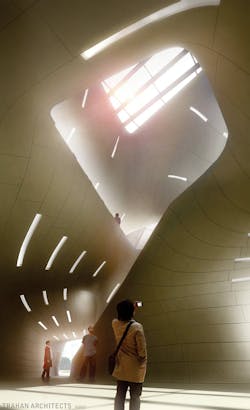BIM Clarification and Codification in a Louisiana Sports Museum
The Louisiana State Sports Hall of Fame is currently being built in Natchitoches, one of the Old West settlements in the Louisiana Purchase. The $12 million, 22,000-sf project will celebrate memorabilia donated by 250 Cajun country sports heroes and showcase their impact on the state. Trahan Architects of Baton Rouge designed a contemporary, curvilinear building to express not just local materials, but the land of northern Louisiana, too.
When it’s completed next March, the building will be in the form of a curvilinear museum substructure situated in a box of native cypress-timber planks. According to Victor “Trey” Trahan, FAIA, president and principal-in-charge of Trahan Architects, the design of the building itself is meant to recall both the hilly topography of northern Louisiana and the flow of the Cane River, while the exterior box controls light and shadow outside the building. Fluid shapes of river channels are separated by interstitial masses in the curvilinear structure, the same way that delta islands separate the waters of a river, thus creating the organizing principle for visitor circulation and gallery arrangement in the museum.
However, that expressive design required coordination and planning that just wouldn’t be possible without the use of 3D BIM. While this was a traditional design-bid-build project, the owner, the state of Louisiana, and the design architect both wanted a BIM consultant to oversee the creation of the precast concrete panels on the substructure inside the outer box. Trahan also required that five-axis CNC milling be used for the formwork of the exterior panels. Case Building + Technology, a BIM and integrated practice consultancy based in New York, was originally brought into the Building Team by the architect, but eventually became a design consultant and BIM manager for the construction manager, VCC of Little Rock, Ark. Case was founded in 2008 by several former members of SHoP Architects, a firm that delivered some very intricate BIM projects, including the 290 Mulberry Street Condominiums (http://www.290mulberry.com) in New York.
“There needed to be expertise at the level of panel fabrication that typically is just not available to the design architect that early in the process,” said Federico Negro, the partner-in-charge on the project for Case Building + Technology.
Trahan Architects used Rhino 3D (.3dm file format), a NURBS tool, for the free-form, curvilinear exterior skin model of the substructure. Trahan originated that model in Autodesk Maya, a 3D animation software used mainly by the film and gaming industries, and brought it into Rhino to add geometric information. They also provided an Autodesk Revit (.rvt) model of the entire project. Still, without actual field conditions built into the model, the precast concrete panels themselves couldn’t be molded and created with any level of detail necessary for installation. Case analyzed the entire skin model and determined that a total of 1,030 separate precast panels would be needed with 4-8 connections to the underlying steel frame for each panel. The whole surface was analyzed for gaps and constructability questions, and all gaps had to be fixed on the model’s surface. Each pair of connecting panels had to achieve a tolerance of a quarter-inch between them.
They also had to coordinate connections with the model of structural engineer, LBYD of Birmingham, Ala. The support steel had to be analyzed for clash detection with the concrete panels. Two clash detection programs were used on the project: Gehry Technologies’ Digital Project and Autodesk Navisworks Manage. All panel-to-panel clearance detection was done in Digital Project. For trade coordination, which fell under Case’s purview as the overall BIM manager for VCC, Navisworks was used because of its robust import/export capabilities and the sheer numbers of different software packages (14 different programs) the trade subcontractors were using on the project.
“That’s just the way we like to work,” said Case Building + Technology’s Negro. “We’re not going to specify something else for a fabricator or anyone else to learn and use on a project. We want to be as far from top-down as possible. Working directly for the CM and down through all trades gave us a much bigger perspective of the overall project and really integrated everyone on the team.”
Once the design skin model was rationalized, made seamless, and quality-checked for constructability, an automated program then sent a unique shop ticket for each panel to fabricator Advanced Cast Stone of Fort Worth, Texas. The shop tickets were created in Rhino via Rhinoscript. The script took a computer folder of panel file information and automatically created a shop ticket for each panel. The program automatically placed the embed points on the panel, prepared a fabrication file for molds, and created all the cameras and views needed for the visual part of the ticket itself. The script also created a table articulating and explaining all the different embed types on that panel. That information went into the shop ticket and an accompanying .csv file capable of being opened in Microsoft Excel. This automated process created a simple set of points to tell the shop what was needed to create each of the 1,030 panels delivered in a STEP (.step). Four corners and connection points were named and articulated in each shop ticket, and a shop drawing accompanied each ticket.
To track coordination problems between structural, MEP, and fire protection, Case used Web-based tracking tool Jira (https://www.atlassian.com/software/jira), developed by Australian software company Atlassian, which is primarily used for tracking bugs in computer code. However, it worked just as well for tracking clashes as it does for finding bugs.
All the precast concrete panels have now been fabricated, and installation began in early August in Natchitoches. The project is on track to open in March.
“Protecting design intent is always a big factor here,” Negro said. “Having people that can demystify surfaces and geometry is a big part of what we do, and it is hard work on such a complex design, but it’s not impossible to preserve that design. Not even close.” BD+C
